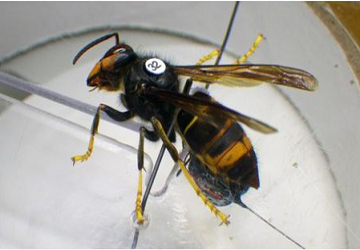论文标题:Searching for nests of the invasive Asian hornet (Vespa velutina) using radio-telemetry
期刊:Communications Biology
作者:Peter J. Kennedy et al
发表时间:2018/07/04
数字识别码:10.1038/s42003-018-0092-9
原文链接:https://www.nature.com/articles/s42003-018-0092-9?utm_source=Other_website&utm_medium=Website_linksWebsite_links&utm_content=RenLi-MixedBrand-OAB-Multidisciplinary-China&utm_campaign=OAB_USG_JRCN_RL_article_promotion_sciencenet_Sep_1st

亚洲大黄蜂是一种对欧洲授粉昆虫有着巨大威胁的侵略性外来物种。亚洲大黄蜂于2005年第一次在法国被发现,每年蔓延约60至78公里,有时因人为因素会传播至更远处。这不但会影响养蜂业和蜂蜜生产业,也对庄稼和野花的授粉有影响。亚洲大黄蜂会等在蜜蜂巢的入口,对回巢的蜜蜂进行捕食。蜜蜂群因此会闭门不出,这不光导致蜂蜜产量的下降,蜜蜂甚至可能因缺少食物而饿死。
据法国养蜂人的粗略估计,有亚洲大黄蜂繁殖的区域损失了5%到80%的蜜蜂群(平均30%)。所以养蜂人必须尽快地找到大黄蜂群,并在繁殖季节前把它们摧毁。然而,大黄蜂巢隐蔽性很好,常建于树上或浓密的灌木从里,并常建于城市里。现有寻找蜂巢的方法多数为视觉寻找,需要很多时间,人力和物力。其他的方法,例如谐波雷达则需在开阔平坦的空间才能够有效地跟踪昆虫,而热成像仪必须在离大黄蜂巢很近的地方才有用。
过去的50年间,人们一直用无线电遥测法来追踪脊椎动物:抓捕单个动物,在它们身上绑定追踪标签,然后释放并追踪信号直至发现他们的群居地。这种方法被命名为“犹大法”。这种方法价格适中且非专业人士也可使用。之前该法一直被使用于哺乳类动物,鸟类及鱼类身上。最近才被使用于害虫身上。
在《通讯-生物学》发表的Searching for nests of the invasive Asian hornet (Vespa velutina) using radio-telemetry一文里,英国埃克塞特大学的Peter Kennedy的团队声称,这是第一次有研究讨论是否可以将该方法运用于社会性昆虫身上。

图1:用无线电遥测追踪贴上标签的大黄蜂,让它变成“犹大”。
作者们成功地用无线电遥测法,在释放“犹大”后几小时内就成功地发现了五处蜂巢。无线电遥测比以前的方法效率更高,效果也更好,但也有局限。现有的标签必须贴在体积较大的大黄蜂身上,而新建的蜂巢因黄蜂总数不多,体积大的个体少,比较难以找到。但只要找到一个体积大的大黄蜂,便可以追踪至巢穴。
总的来说,无线电遥测这个方法不但能帮助养蜂人摧毁大黄蜂窝,而且可以密切监察大黄蜂的生态和行为,推进对物种入侵带来的影响的研究工作。
摘要:Asian hornets (Vespa velutina) are voracious predators of bees, and are the latest emerging threat to managed and wild pollinator populations in Europe. To prevent establishment or reduce the rate of spread of V. velutina, early detection and destruction of nests is considered the only option. Detection is difficult as their nests are well hidden and flying hornets are difficult to follow over long distances. We address this challenge by tracking individual V. velutina workers flying back to their nests using radio telemetry for the first time, finding five previously undiscovered nests, up to 1.33 km from hornet release points. Hornets can fly with 0.28 g tags if the tag:hornet ratio is less than 0.8. This method offers a step-change in options to tackle the spread of this invader, providing an efficient means of finding V. velutina nests in complex environments to manage this emerging threat to pollinators.
阅读论文全文请访问:https://www.nature.com/articles/s42003-018-0092-9?utm_source=Other_website&utm_medium=Website_linksWebsite_links&utm_content=RenLi-MixedBrand-OAB-Multidisciplinary-China&utm_campaign=OAB_USG_JRCN_RL_article_promotion_sciencenet_Sep_1st
期刊介绍:Communications Biology is an open access journal from Nature Research publishing high-quality research, reviews and commentary in all areas of the biological sciences. Research papers published by the journal represent significant advances bringing new biological insight to a specialized area of research.
(来源:科学网)
特别声明:本文转载仅仅是出于传播信息的需要,并不意味着代表本网站观点或证实其内容的真实性;如其他媒体、网站或个人从本网站转载使用,须保留本网站注明的“来源”,并自负版权等法律责任;作者如果不希望被转载或者联系转载稿费等事宜,请与我们接洽。